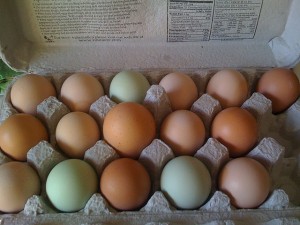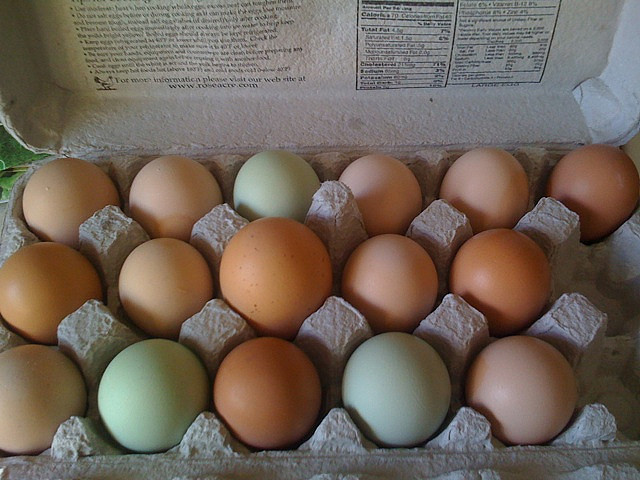
When I purchased my chicks in 2007, I knew next to nothing about chicken raising in real life. All of my knowledge was derived from books, MyPetChicken.com, and BackyardChickens.com. Of course, all of these are ‘pro-chicken’ resources, but they also told me about diseases, care, costs and housing requirements. I learned a lot in my first year and now I’m not an expert by any stretch of the imagination, but experience and knowledge are key in making valid arguments.
Some good tips for keeping your chickens, the neighbors, and city officials, at bay:
Building Design
Design something that is multipurpose. Consider if chicken raising isn’t for you, can the building make a good shed or potting house? Build something that is asthetically pleasing. Choose paint colors that match the house, or follow the trends in English gardens recently and paint all the outbuildings one color (i.e. coop and shed match). I built my coop out of some recycled materials, but I decided to choose wisely. The exterior of the building shouldn’t be ramshackle.
Decide on a good size. How many chickens do you want to keep? What will provide them with good ventilation? As chicken droppings break down, they form ammonia. Litter that stays moist can also harbor illness (coccidia for one) and cause respiratory aggravation. Recommended space, design and other tips can be found here from Virginia Tech.
Work in easy numbers – like 8′ ceiling, or 4′ if you’re doing a small chicken hut – this way you can maximize use of purchased 2x4s and not have a lot of falloff. See here for some good designs – some are more suburban friendly than others. Le Poulet Chalet was even featured on HGTV for its design. Here is even a chicken ark plan from our beloved Marley & Me author, John Grogan.
Pen Design
Pens should be secure, durable and attractive. Chicken wire with staples to wooden beams can easily be rammed by a stray dog or other chicken chasing wild animal. I chose a 10x10x6 chainlink dog kennel kit and bought an additional 12′ panel for a little under $200 at the farm supply. My coop is 12′ long, so I put two 10′ panels on each side with a 12′ panel on the end being sure to attach the panels to the coop with bolts! I also had to use something to accommodate the slope of the land, so I chose attractive landscape blocks to level the ground for each panel to step down.
Landscaping around the pen will help cut noise and block them from neighbors’ sight, if that is an issue. It also could help cut the wind and provide shade for the chickens during the various seasons. Pampas grasses are great natural shields. They grow 8 – 10′ high, are perennial, but they must be divided annually to avoid taking over your lawn.
Many of you may choose to free range your flock, which is great, but consider several pros to having a pen:
Less flock loss
They won’t get in the street
Some birds roost in trees if let out
They don’t eat your garden, or your neighbors’
You will have less chicken ‘do’ on your yard, deck, driveway, etc.
The Bockers
Choosing the right birds is key. You want birds that are friendly, bare confinement well and aren’t flighty. I haven’t had many birds go broody (want to hatch eggs), even if they were listed to be broody. Try MyPetChicken.com’s breed selector tool. Want both standard breeds and bantams? Stick with either one or the other, I have found. The bantams get picked on by bigger birds, lay smaller eggs and are easier for hawks and other aerial predators to carry away.
Do not get guineas, peafowl or roosters for your flock. Those are all very noisy birds. Roosters don’t just crow in the morning, they crow at 2 a.m., 12 p.m., 7:14 p.m. and so forth. Chris and I have often woken up to Joe’s crowing at 3 a.m. Roosters can also be aggressive. My rooster of 2007 spurred me and cut me through my jeans. If that had been my daughter, it would have been her face. I got rid of him promptly that evening.
Against Arguments
They smell – sure, anything can though if you don’t pick up properly after it. I change the litter every few months.
They’re noisy – much less than a dog or some playing children.
They carry diseases – not many that are zootonic. And no, the avian flu isn’t in any backyard flocks I know of.
They’re undesirable – to whom? I loathe yappy dogs, but it isn’t my property nor my choice regarding the neighbor’s pooch.
Decrease property value – my nice little coop actually raised my property value. Keeping it nice is the key though.
Why is this such an issue? Is it right for someone else to tell someone what they can do with their property? If someone doesn’t like my chickens, what keeps me from saying I don’t like their shed or deck? Or their obnoxious barking dog? Their fence that needs painting? If chickens are kept clean in neat housing, they are not a problem to anyone. I cannot even hear my hens bocking (the “I laid an egg” community celebration) with my windows closed. I can barely hear them if I have my windows open and theirs closed. Besides, my neighbors love my chickens. They enjoy watching them put around the yard, and theirs too (although I discourage them from such). One neighbor even tosses out scraps for them.
Recent Articles about Chickens in St. Louis County
Chickens vs. property values (By the way, Merryl, quoted in the article, hosts wonderful cheese making classes!)
Council amends “chicken law” to smooth ruffled feathers (Previous article about Chesterfield chickens, and another)
If you have more questions, please feel free to leave comments.


